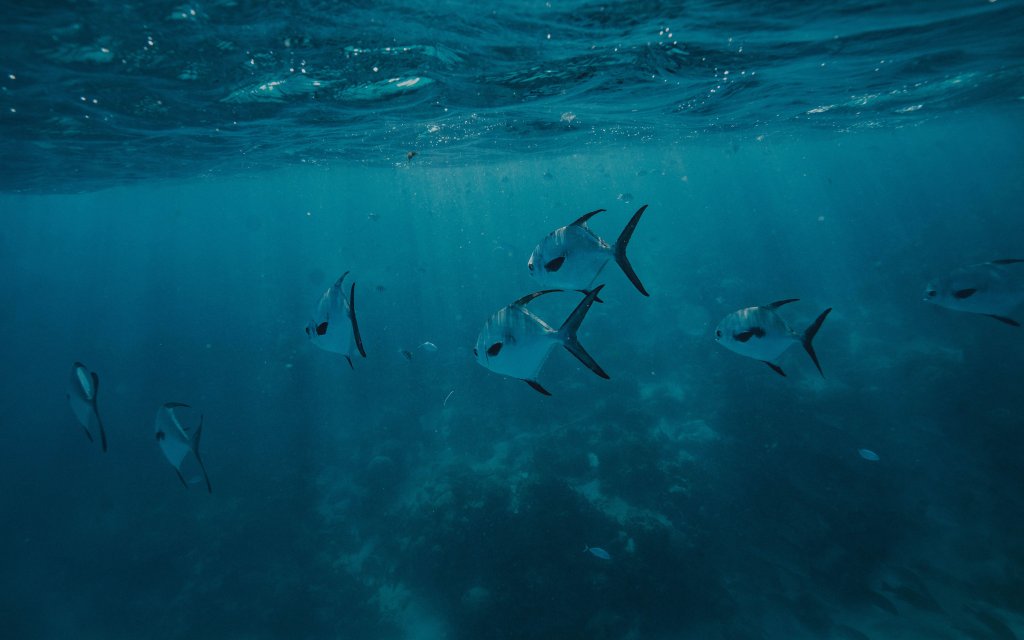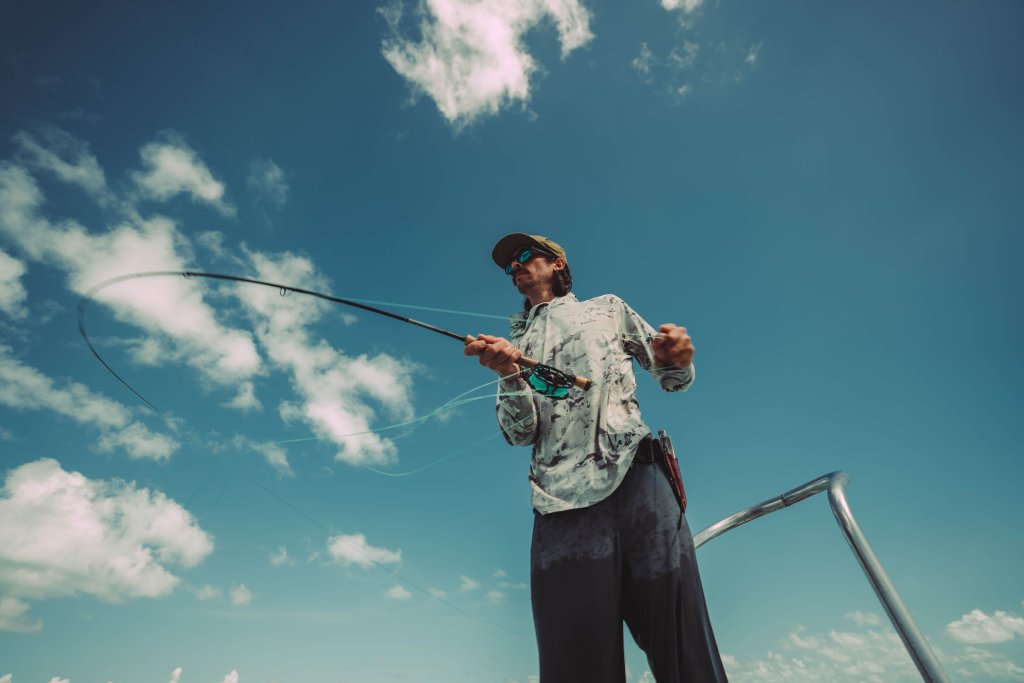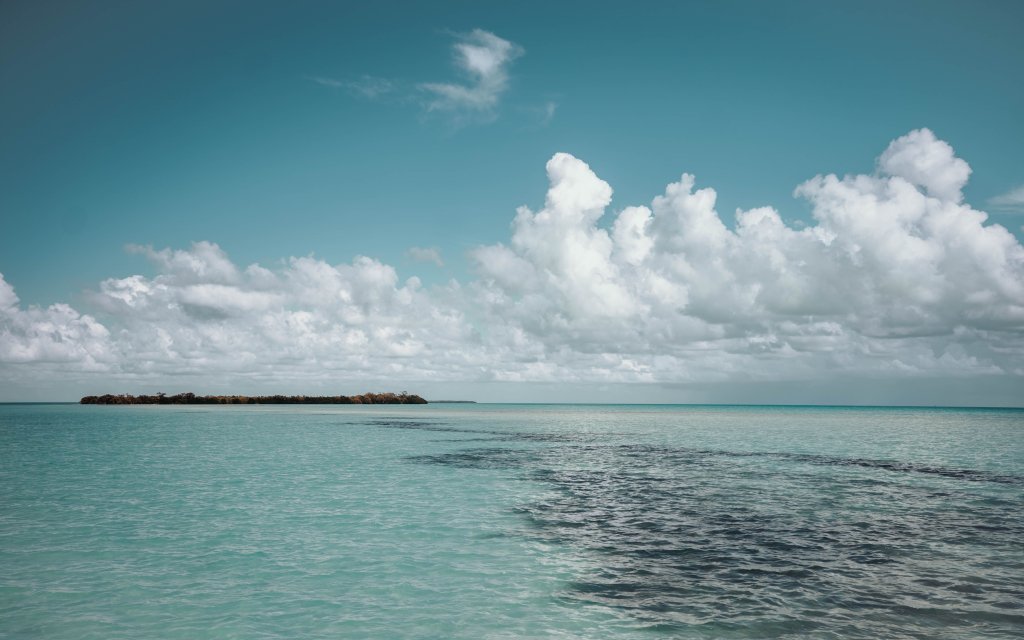What’s so Special About Permit Fishing in Belize?
The elusive permit is considered by fly fishers as the toughest of the inshore saltwater quarry. Wary and suspicious — and in possession of some otherworldly trait that allows it to appear and disappear, seemingly at will — the permit is the fish of a lifetime for most saltwater fly anglers.
As tough as they can be to convince into eating a fly, they can be caught. There are opportunities around the world to catch permit ranging from just a few pounds to as much as 30 pounds or more. In tropical locales across the Caribbean, permit are plentiful and “shots” at these fish can be had regularly. And one of the best places to get shots at permit is on the sun-drenched flats of Belize. Here is what you should know about permit fishing in Belize.

Belize is a permit factory
Situated south of Mexico and east of Guatemala in northern Central America, Belize is a welcoming, English-speaking country with a rich history in inshore and flats fly fishing. There are a number of lodges along the country’s Caribbean coast, and many of them work to dial in their local permit fishery. That makes sense, of course, because permit are plentiful in the shallow waters of coastal Belize, where the habitat is ideal and the prey base is plentiful.
Lodges like the Blue Bonefish Lodge in San Pedro on renowned Ambergris Cay can give anglers excellent opportunities at permit fishing in Belize. Add in excellent accommodations, wonderful hospitality and the stunning location right on the Caribbean, and anglers who visit may not want to leave.

Of course, proximity to permit doesn’t always translate into permit success. These fish are prized, not because they’re plentiful or have a penchant for hitting a fly. Even in Belize, where the population is strong, permit are valued because they are very difficult to catch — they pose a unique challenge to even the most-seasoned flats angler. Everything must come together just right for any angler to end up posing with a nice permit at the end of an epic battle on the flats. It’s fly-fishing calculus, where every variable must be considered in order to be successful. The cast must be solid. The fly needs to be up to snuff for the fish to even give it a look. The retrieve must be life-like and convincing. And that says nothing about other more subtle elements, like the light, the wind or even the moon phase.
There are other factors involved in permit fishing in Belize, too, like spotting the fish in the first place. A good guide can spot fish hundreds of yards away, and in Belize, that means that guides must not only find the fish, but also get the boat — usually a solid, shallow-draft panga — in the right position for the angler on the bow of the boat to make a good cast. It’s a complicated dance among the guide, the angler, the elements and the fish, and if just one of the four misses a beat, the chances of convincing a trophy fish to hit a fly diminish significantly.
But, a prepared angler stands a better chance. Here’s how to get ready for permit fishing in Belize.
Necessary Gear for Catching Permit

Rods and Reels for Permit Fishing in Belize

Fly fishers hoping to catch permit on the Belizean flats should arrive in country with at least an 8-weight saltwater fly rod (a 9 or 10-weight would be an even better bet). A fast-action rod loaded with a dependable floating saltwater fly line the same weight as the rod is the first and most-necessary implement any permit-hopeful angler will need. Second, a good saltwater reel is a must, and that reel needs to be loaded with at least 200 yards of 30-pound backing. There are plenty of cheaper reels available, but, as with just about any endeavor, you get what you pay for. If you’re serious about landing a permit, particularly a large one, don’t skimp on the reel (and don’t skimp on the rod, either).
Leaders and Tippet for Permit Fishing:

The use of fluorocarbon leaders and tippet is crucial to success in the gin clear waters of Belize. Starting with a 9 or 10 foot fluorocarbon leader and then adding 4-5 feet of 16lb or 12lb fluorocarbon tippet to that leader making the total leader length 13-14 feet will increase your success.
The best flies for Permit Fishing in Belize

Permit flies abound, and vise-monkeys from around the Caribbean often claim to have the next “must-have” pattern for permit. While Blue Bonefish Lodge and guides will have flies to share with clients + flies available for purchase, it’s always a good idea to arrive in Belize with a few appropriate fly patterns already in hand.
For the most part, guides in Belize will likely recommend crab or larger shrimp patterns for permit, although some simply prefer to “upsize” simple bonefish flies like Gochas or Crazy Charlies, because permit eat generally the same things that bonefish eat — shrimp and crabs. Permit have hard crushers in their jaws that allow them to gobble down hard-shelled crabs, pincers and all. The fish’s diet consists almost entirely of shellfish and mollusks, but they will chase baitfish sometimes, and every now and then, a tale will emerge about an angler latching on to a big permit using a Clouser Minnow.
Generally speaking, though, crab and shrimp patterns are the go-to flies for permit in Belize. On the flats surrounding Ambergris Caye the guides will help choose the right fly for the situation. If the permit are shallow and tailing, your guide may opt for a crab fly fished on the bottom. Quite often the permit are floating in deeper water on the edges of the flats and a shrimp fly may be best suited to encourage a mid-water column eat from the permit.
Communicate with the lodge you’re planning to visit. They’re the experts in what local permit prefer. Take their advice. Your success is important to them, so they’re not going to steer you in the wrong direction.

Blue Bonefish Lodge has put together a custom package of flies that is suited for the flats surrounding our Lodge.This will cover most situations for the big three on the flats! That list can be found HERE.
That said, here are few suggested fly patterns for permit fishing in Belize:
- The Strong Arm Crab – Size 2 and 4 (Olive and Tan)
- The Avalon permit fly – Size two and 4 (Tan)
- The Raghead Crab – Size 4 (Tan w/ white legs)
- The Bauer Crab Size 4 and 6 (Olive and Tan)
- The Veverka Mantis Shrimp Size 2 and 4 (Tan and Olive)
All of the patterns above are permit catchers, but it’s still important to check with the lodge you’re visiting so you can show up to fish with patterns they know will work. For more flies for fishing in Belize, read our article: “The Best Flies for Belize“
Additional Gear for Permit in Belize:

There are other necessities for permit fishing in Belize of course, ranging from a good pair of polarized sunglasses (amber or brown lenses) to just the right fly pattern and the ideal leader built to withstand the brutish strength of a big permit, but first and foremost solid, dependable hardware is an absolute must for catching permit (and, frankly, any fish on the Belizean flats, including bonefish, tarpon, jacks and even snappers). Wading boots are also important, as many situations encourage wading on coral/muddy bottoms to a sensitive school of tailing permit on a skinny water flat.
Important Techniques for Permit Fishing in Belize

Fly fishing for permit, while similar, is not exactly like fly fishing for bonefish. Yes, the two fish often share the same habitat, and in Belize, they’ll often cruise the flats together. But the techniques for permit are different. Here are some basics:
- Permit are more deliberate than bonefish, which can sometimes cruise the flats randomly. Generally, permit cruise faster and appear to be headed somewhere intentionally. Because of this, the permit angler must possess a solid saltwater(50ft or more) fly cast and be able to load a rod and cast with little fanfare in order to place a fly in the path of cruising fish. Most land-locked anglers don’t intuitively possess this skill, and it must be learned. And, of course, it must be practiced. Some guides, on a multi-day trip for permit, will intentionally spend the first day with their new angler chasing bonefish. This helps shake the rust off a saltwater cast that might have been dormant for months or longer. The double-haul cast that’s a staple for inshore anglers isn’t an ingrained skill in most fly fishers who spend the bulk of their time casting for trout or bass, so a day spent honing or reawakening these skills is important. Also, spending a day on the flats in pursuit of bones helps anglers dial in their “fish eye,” so it’s good and ready when permit are on the menu.

- For bonefish, anglers are often instructed to strip quickly in short little bursts in order to get the attention of hunting fish. For permit, guides will instruct the angler on the bow of the Belizean panga to strip long and slow. This makes sense, because crabs, when retreating from predators, make long, deliberate runs.
- As with virtually every other saltwater quarry, when a permit does decide to eat, the guide will be sure to instruct the angler to stip-set the fish rather than lift the rod to set the hook. The latter is a trout-angler trait — it’s the best way to hook fish that eat diminutive dry flies and nymphs. But saltwater fish, permit included, are in possession of tough mouths that are used to crush crabs, shrimp and mollusks — by strip-setting, anglers aren’t pulling flies out of the mouths of fishing, but rather driving the point of the saltwater hook into the mouth of the fish, securing the hookup. As they say in Belize, “keep calm and don’t trout set.”
- It is also important to watch the permit very closely as they commit and begin to chase your fly. As with most saltwater flats species this can be a “cat and mouse game” and you need to feed the fish! .Here are two important tips that will help increase your odds. 1. Watch for the permit to shutter or shake. If you see this often the permit has grabbed the fly and with a long slow strip you may not feel the fish. if you see the permit shutter quickly transition into a long fast strip to see if you can feel the weight. If you feel the weight give one more long strip to secure the permit. 2 If the permit has chased the fly for 2-3 long strips and has not committed to fly and eaten, try and stop stripping for a few seconds and let the fly fall to the bottom and watch the fish closely for the shutter and shake to see if they eat while it falls. If you see this quickly give one long to see if the permit is there. This technique will often encourage an eat as most of their food permit eat will try to flee towards the bottom and dig into the sand or grass to hide.
How to Find Permit

Finding permit on the flats, even when their numbers are strong, is easier said than done. Often, it requires hours of standing on the bow of a panga, glaring off into the hip-deep waters of an emerald-green flat. While your guide will be scanning the flats with seasoned eyes, you can also be a part of the hunt with these tips for spotting the fish — because permit can’t be caught if they can’t be seen:
- Look for rays: The abundance of stingrays in Caribbean waters is a good thing for permit, and for permit anglers. Rays cruise the flats, often in pursuit of the very same food that a permit might eat, and they stir up “food” from the flats. For this reason, permit will often follow rays across the flats — sometimes a few yards back and sometimes seemingly right on the bigger fish, looking for crabs or shrimp to kind of squirt out from under the ray. Any anglers who sees a ray on the flats should immediately spend some time looking behind the ray for following permit.
- Permit also tend to ride high in the water column to have a better view of the bottom and what’s beneath them. Try to focus farther out than you think (50-200 feet) in front of the boat, and in Belize you will often see larger schools swimming together, spotting them from a distance is common!
- The permit’s sickle-shaped fins (black filet knife in the water) are a dead give-away, and anglers should always be on the lookout for these fins slicing through the water. Look for reflections of sunlight off the fins and, on calmer days, look for “nervous” or “busy” water that moves deliberately. Most guides will spot the fish first, but it never hurts to have two sets of eyes looking for these elusive fish.

- Yes, polarized sunglasses might be a “gear” item, but for spotting fish on the flats, they are a must. Polarized lenses (amber or brown tint) reduce glare and allow anglers to see into the water. Without them, an angler is at the mercy of a guide’s instructions. Even in English-speaking Belize, the Creole accent can be tough to decipher, so being able to see the fish will help with everything from the cast to the strip to that fateful strip-set.
- Trust the guide. Sounds simple, but fly fishers are a finicky lot, and many enjoy the deductive approach to finding and catching fish. But, for any angler on a guided permit adventure, the best advice is to follow the guide’s instructions. Think about it. If the angler on the bow of the boat is successful, the guide is successful, too. And permit guides chase these fish every single day — why question their expertise?

The Final Word on Permit in Belize
Permit are plentiful in Belize — it might be one of the most dependable destinations in the Caribbean to find and catch these prized fish. But, as noted above, everything needs to come together when chasing permit for anglers to be successful. Dependable gear — from quality rods and reels to the appropriate fly line, leaders, tippets and backing — is a must. Coming to Belize with the right equipment will help immensely.

Anglers must also come armed with the right flies in the right sizes, and fly weights should vary. Sometimes, anglers will find themselves casting to permit in eight feet of water, and a heavier fly will be needed to get the fly down far enough to tempt the fish. At other times, guides may be looking for permit in knee-deep water, where a lighter fly might be needed.
Almost as important as the gear is the possession of the necessary skills to cast to and catch the prized fish of the flats. A double-haul cast will add distance and the ability to slice through the ever-present wind on the flats. Anglers who don’t possess a dependable saltwater cast will struggle on the flats. So practice. A lot.

Having patience, and staying persistent, equals permit! Not every day is going to be perfect, bluebird conditions, and calm winds. You will deal with some clouds, and stronger winds most days. Allow your guide to run his program, he will check numerous flats throughout the day. You may pole and fish three or four areas without seeing a fish, and then the next stop you find the school of permit. Odds are he knows where the permit are hiding and is working extremely hard to get you as many shots as he can throughout the day!
Finally, fly fishers should know what they’re looking for. Yes, the guide will very likely see the fish first, but anglers should come equipped with a quality pair (or two) of polarized sunglasses and be that valuable second set of eyes in the hunt for permit.

Belize is one of the best permit destinations in the world, but there’s no guarantee that a permit will come to hand just by showing up. Anglers should come prepared with the right gear and equipment and, frankly, with the right mindset. Fishing for permit can be a taxing endeavor — the better-prepared angler will almost always be the most successful.
Where to go Permit Fishing in Belize:
Blue Bonefish Lodge offers some of the best Permit, Bonefish, and overall salt water flats fishing offered South of the Equator. To book a stay at our beautiful lodge, Click HERE for details. We look forward to hosting you soon!

All photos courtesy of Flylords Media
Read More:


Recent Comments